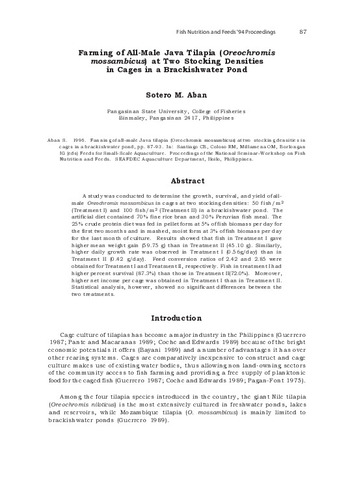Farming of all-male java tilapia (Oreochromis mossambicus) at two stocking densities in cages in a brackishwater pond
- Global styles
- MLA
- Vancouver
- Elsevier - Harvard
- APA
- Help
Share
Abstract
A study was conducted to determine the growth, survival, and yield of allmale Oreochromis mossambicus in cages at two stocking densities: 50 fish/m2 (Treatment I) and 100 fish/m2 (Treatment II) in a brackishwater pond. The artificial diet contained 70% fine rice bran and 30% Peruvian fish meal. The 25% crude protein diet was fed in pellet form at 5% of fish biomass per day for the first two months and in mashed, moist form at 3% of fish biomass per day for the last month of culture. Results showed that fish in Treatment I gave higher mean weight gain (59.75 g) than in Treatment II (45.10 g). Similarly, higher daily growth rate was observed in Treatment I (0.56g/day) than in Treatment II (0.42 g/day). Feed conversion ratios of 2.42 and 2.85 were obtained for Treatment I and Treatment II, respectively. Fish in treatment I had higher percent survival (87.3%) than those in Treatment II(72.0%). Moreover, higher net income per cage was obtained in Treatment I than in Treatment II. Statistical analysis, however, showed no significant differences between the two treatments.
Suggested Citation
Aban, S. (1996). Farming of all-male java tilapia (Oreochromis mossambicus) at two stocking densities in cages in a brackishwater pond. In: C.B. Santiago, R.M. Coloso, O.M. Millamena & I.G. Borlongan (Eds.). Feeds for Small-Scale Aquaculture. Proceedings of the National Seminar-Workshop on Fish Nutrition and Feeds (pp. 87-93). Tigbauan, Iloilo, Philippines : SEAFDEC Aquaculture Department.
Type
Conference paperCollections



